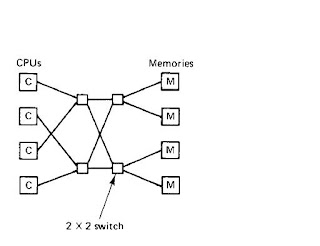Switched-based
Switched systems do not have a single backbone like cable television. Instead, there are individual wires from machine to machine, with many different wiring patterns in use. Messages move along the wires, with an explicit switching decision made at each step to route the message along one of the out-going wires. The worldwide public telephone system is organized in this way.
Switched Multiprocessors
To form a Switched Multiprocessors system with more than 64 processors, we need different methods to connect the CPUs with the memory.
● A Crossbar Switch &
● An Omega Switching Network
● NonUniform Memory Access
A Crossbar Switch
Each CPU and each memory (memory divided into modules) has a connection coming out of it, at every
intersection is a tiny electronic crosspoint switch that can be opened and closed in hardware, as shown in
Fig.6. When a CPU wants to access a particular memory, the crosspoint switch connecting them is
closed momentarily, to allow the access to take place.
The virtue of the crossbar switch is that many CPUs Fig.6 A Crossbar Switch can be accessing memory at the same time, although if two CPUs try to access the same memory simultaneously, one of them will have to wait.
To build a multiprocessor based on the crossbar switch with n CPUs and n memories, n2 crosspoint switches are needed. For large n, this number can be prohibitive. So alternative switching networks is The Omega Network as shown in fig
An Omega Switching Network
This network contains four 2 x 2 switches, each having two inputs and two out-puts. Each switch can
route either input to either output. A careful look at the figure will show that with proper settings of the
switches, every CPU can access every memory.
These switches can be set in nanoseconds or less. In the general case, with n CPUs and n memories,
requires log2n switching stages, each containing n/2 switches. Although for large n this is much better than n2, it is still substantial.
There is another problem: delay. For example, for n = 1024, there are 10 switching stages from the CPU to the memory, and another 10 for the word requested to come back.
NonUniform Memory Access
Attempted to reduce the cost by using to hierarchical systems. Some memory is associated with each CPU. Each CPU can access its own local memory quickly, but accessing anybody else's memory is slower. This design gives rise to a NUMA machine. Although NUMA machines have better average access times than machines based on omega networks, they have the new complication that the placement of the programs and data becomes critical in order to make most access go to the local memory.
To form a Switched Multiprocessors system with more than 64 processors, we need different methods to connect the CPUs with the memory.
● A Crossbar Switch &
● An Omega Switching Network
● NonUniform Memory Access
A Crossbar Switch
Each CPU and each memory (memory divided into modules) has a connection coming out of it, at every
intersection is a tiny electronic crosspoint switch that can be opened and closed in hardware, as shown in
Fig.6. When a CPU wants to access a particular memory, the crosspoint switch connecting them is
closed momentarily, to allow the access to take place.
The virtue of the crossbar switch is that many CPUs Fig.6 A Crossbar Switch can be accessing memory at the same time, although if two CPUs try to access the same memory simultaneously, one of them will have to wait.
To build a multiprocessor based on the crossbar switch with n CPUs and n memories, n2 crosspoint switches are needed. For large n, this number can be prohibitive. So alternative switching networks is The Omega Network as shown in fig
An Omega Switching Network
This network contains four 2 x 2 switches, each having two inputs and two out-puts. Each switch can
route either input to either output. A careful look at the figure will show that with proper settings of the
switches, every CPU can access every memory.
These switches can be set in nanoseconds or less. In the general case, with n CPUs and n memories,
requires log2n switching stages, each containing n/2 switches. Although for large n this is much better than n2, it is still substantial.
There is another problem: delay. For example, for n = 1024, there are 10 switching stages from the CPU to the memory, and another 10 for the word requested to come back.
NonUniform Memory Access
Attempted to reduce the cost by using to hierarchical systems. Some memory is associated with each CPU. Each CPU can access its own local memory quickly, but accessing anybody else's memory is slower. This design gives rise to a NUMA machine. Although NUMA machines have better average access times than machines based on omega networks, they have the new complication that the placement of the programs and data becomes critical in order to make most access go to the local memory.




Comments
Post a Comment